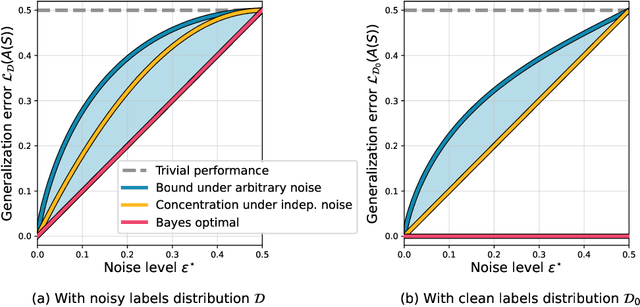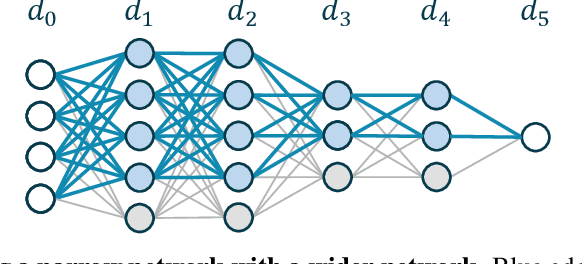Nathan Srebro
TTIC
On the Hardness of Learning Regular Expressions
Oct 06, 2025Abstract:Despite the theoretical significance and wide practical use of regular expressions, the computational complexity of learning them has been largely unexplored. We study the computational hardness of improperly learning regular expressions in the PAC model and with membership queries. We show that PAC learning is hard even under the uniform distribution on the hypercube, and also prove hardness of distribution-free learning with membership queries. Furthermore, if regular expressions are extended with complement or intersection, we establish hardness of learning with membership queries even under the uniform distribution. We emphasize that these results do not follow from existing hardness results for learning DFAs or NFAs, since the descriptive complexity of regular languages can differ exponentially between DFAs, NFAs, and regular expressions.
Learning single-index models via harmonic decomposition
Jun 11, 2025Abstract:We study the problem of learning single-index models, where the label $y \in \mathbb{R}$ depends on the input $\boldsymbol{x} \in \mathbb{R}^d$ only through an unknown one-dimensional projection $\langle \boldsymbol{w}_*,\boldsymbol{x}\rangle$. Prior work has shown that under Gaussian inputs, the statistical and computational complexity of recovering $\boldsymbol{w}_*$ is governed by the Hermite expansion of the link function. In this paper, we propose a new perspective: we argue that "spherical harmonics" -- rather than "Hermite polynomials" -- provide the natural basis for this problem, as they capture its intrinsic "rotational symmetry". Building on this insight, we characterize the complexity of learning single-index models under arbitrary spherically symmetric input distributions. We introduce two families of estimators -- based on tensor unfolding and online SGD -- that respectively achieve either optimal sample complexity or optimal runtime, and argue that estimators achieving both may not exist in general. When specialized to Gaussian inputs, our theory not only recovers and clarifies existing results but also reveals new phenomena that had previously been overlooked.
Temperature is All You Need for Generalization in Langevin Dynamics and other Markov Processes
May 25, 2025Abstract:We analyze the generalization gap (gap between the training and test errors) when training a potentially over-parametrized model using a Markovian stochastic training algorithm, initialized from some distribution $\theta_0 \sim p_0$. We focus on Langevin dynamics with a positive temperature $\beta^{-1}$, i.e. gradient descent on a training loss $L$ with infinitesimal step size, perturbed with $\beta^{-1}$-variances Gaussian noise, and lightly regularized or bounded. There, we bound the generalization gap, at any time during training, by $\sqrt{(\beta\mathbb{E} L (\theta_0) + \log(1/\delta))/N}$ with probability $1-\delta$ over the dataset, where $N$ is the sample size, and $\mathbb{E} L (\theta_0) =O(1)$ with standard initialization scaling. In contrast to previous guarantees, we have no dependence on either training time or reliance on mixing, nor a dependence on dimensionality, gradient norms, or any other properties of the loss or model. This guarantee follows from a general analysis of any Markov process-based training that has a Gibbs-style stationary distribution. The proof is surprisingly simple, once we observe that the marginal distribution divergence from initialization remains bounded, as implied by a generalized second law of thermodynamics.
Better Rates for Random Task Orderings in Continual Linear Models
Apr 06, 2025


Abstract:We study the common continual learning setup where an overparameterized model is sequentially fitted to a set of jointly realizable tasks. We analyze the forgetting, i.e., loss on previously seen tasks, after $k$ iterations. For linear models, we prove that fitting a task is equivalent to a single stochastic gradient descent (SGD) step on a modified objective. We develop novel last-iterate SGD upper bounds in the realizable least squares setup, and apply them to derive new results for continual learning. Focusing on random orderings over $T$ tasks, we establish universal forgetting rates, whereas existing rates depend on the problem dimensionality or complexity. Specifically, in continual regression with replacement, we improve the best existing rate from $O((d-r)/k)$ to $O(\min(k^{-1/4}, \sqrt{d-r}/k, \sqrt{Tr}/k))$, where $d$ is the dimensionality and $r$ the average task rank. Furthermore, we establish the first rates for random task orderings without replacement. The obtained rate of $O(\min(T^{-1/4}, (d-r)/T))$ proves for the first time that randomization alone, with no task repetition, can prevent catastrophic forgetting in sufficiently long task sequences. Finally, we prove a similar $O(k^{-1/4})$ universal rate for the forgetting in continual linear classification on separable data. Our universal rates apply for broader projection methods, such as block Kaczmarz and POCS, illuminating their loss convergence under i.i.d and one-pass orderings.
PENCIL: Long Thoughts with Short Memory
Mar 18, 2025



Abstract:While recent works (e.g. o1, DeepSeek R1) have demonstrated great promise of using long Chain-of-Thought (CoT) to improve reasoning capabilities of language models, scaling it up during test-time is challenging due to inefficient memory usage -- intermediate computations accumulate indefinitely in context even no longer needed for future thoughts. We propose PENCIL, which incorporates a reduction mechanism into the autoregressive generation process, allowing the model to recursively clean up intermediate thoughts based on patterns learned from training. With this reduction mechanism, PENCIL significantly reduces the maximal context length required during generation, and thus can generate longer thoughts with limited memory, solving larger-scale problems given more thinking time. For example, we demonstrate PENCIL achieves 97\% accuracy on the challenging Einstein's puzzle -- a task even large models like GPT-4 struggle with -- using only a small 25M-parameter transformer with 2048 context length. Theoretically, we prove PENCIL can perform universal space-efficient computation by simulating Turing machines with optimal time and space complexity, and thus can solve arbitrary computational tasks that would otherwise be intractable given context window constraints.
A Theory of Learning with Autoregressive Chain of Thought
Mar 11, 2025Abstract:For a given base class of sequence-to-next-token generators, we consider learning prompt-to-answer mappings obtained by iterating a fixed, time-invariant generator for multiple steps, thus generating a chain-of-thought, and then taking the final token as the answer. We formalize the learning problems both when the chain-of-thought is observed and when training only on prompt-answer pairs, with the chain-of-thought latent. We analyze the sample and computational complexity both in terms of general properties of the base class (e.g. its VC dimension) and for specific base classes such as linear thresholds. We present a simple base class that allows for universal representability and computationally tractable chain-of-thought learning. Central to our development is that time invariance allows for sample complexity that is independent of the length of the chain-of-thought. Attention arises naturally in our construction.
Weak-to-Strong Generalization Even in Random Feature Networks, Provably
Mar 04, 2025Abstract:Weak-to-Strong Generalization (Burns et al., 2024) is the phenomenon whereby a strong student, say GPT-4, learns a task from a weak teacher, say GPT-2, and ends up significantly outperforming the teacher. We show that this phenomenon does not require a strong learner like GPT-4. We consider student and teacher that are random feature models, described by two-layer networks with a random and fixed bottom layer and a trained top layer. A "weak" teacher, with a small number of units (i.e. random features), is trained on the population, and a "strong" student, with a much larger number of units (i.e. random features), is trained only on labels generated by the weak teacher. We demonstrate, prove, and understand how the student can outperform the teacher, even though trained only on data labeled by the teacher. We also explain how such weak-to-strong generalization is enabled by early stopping. Importantly, we also show the quantitative limits of weak-to-strong generalization in this model.
Quantifying Overfitting along the Regularization Path for Two-Part-Code MDL in Supervised Classification
Mar 03, 2025



Abstract:We provide a complete characterization of the entire regularization curve of a modified two-part-code Minimum Description Length (MDL) learning rule for binary classification, based on an arbitrary prior or description language. \citet{GL} previously established the lack of asymptotic consistency, from an agnostic PAC (frequentist worst case) perspective, of the MDL rule with a penalty parameter of $\lambda=1$, suggesting that it underegularizes. Driven by interest in understanding how benign or catastrophic under-regularization and overfitting might be, we obtain a precise quantitative description of the worst case limiting error as a function of the regularization parameter $\lambda$ and noise level (or approximation error), significantly tightening the analysis of \citeauthor{GL} for $\lambda=1$ and extending it to all other choices of $\lambda$.
Tight Bounds on the Binomial CDF, and the Minimum of i.i.d Binomials, in terms of KL-Divergence
Feb 25, 2025Abstract:We provide finite sample upper and lower bounds on the Binomial tail probability which are a direct application of Sanov's theorem. We then use these to obtain high probability upper and lower bounds on the minimum of i.i.d. Binomial random variables. Both bounds are finite sample, asymptotically tight, and expressed in terms of the KL-divergence.
Provable Tempered Overfitting of Minimal Nets and Typical Nets
Oct 24, 2024


Abstract:We study the overfitting behavior of fully connected deep Neural Networks (NNs) with binary weights fitted to perfectly classify a noisy training set. We consider interpolation using both the smallest NN (having the minimal number of weights) and a random interpolating NN. For both learning rules, we prove overfitting is tempered. Our analysis rests on a new bound on the size of a threshold circuit consistent with a partial function. To the best of our knowledge, ours are the first theoretical results on benign or tempered overfitting that: (1) apply to deep NNs, and (2) do not require a very high or very low input dimension.
 Add to Chrome
Add to Chrome Add to Firefox
Add to Firefox Add to Edge
Add to Edge